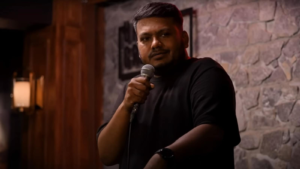
What’s One Major Difference Between Eating at home and eating at a fancy european style restaurant?

Easy: At home we share everything. At Upmarket restaurants we have to eat fancy food carefully arranged by chefs on pretty plates designed for the single diner. Nothing is meant to be shared.
That, I Sometimes Think, is also the basic difference between how Indians (perhaps all asians) and europeans et at restaurants.
We share. They keep it to themselves.
It is, I think, the most important factor in deciding which restaurants successed in India. Think about it. Why do we like going to restaurants that serve butter chicken and biryani? Why do we like places that heap on the hakka noodles so that we can have them with steaming bowls of chicken manchurian? Why do we like large pizzas that everyone can share? Platters of Korean Fried Chicken? Prawn Red Curry for the Whole Table?
Indians like sharing. Even when we Order dishes that are meant for one person – a hamburger, for instance – we will always share the freench friends. All desirts are meant to be eaten communally. Have you ever knowing anyone to order a single jalebi as an individual desirt?
The west was not very different from us on time when even when it came to royal courts and top restaurants. In france, everything used to be served to the same time for everything to share and eat.
Service a la russe or the practice of serving food in courses only started in france in 1810 and did not really catch on Till 1860. even then, Food did not necchen in individula Plates.
The great dishes of french cooking (Say coq au vin or a roast chicken) was meant to be shared. This changes in the 1960s when the nouvelle cuisine movement is over and chefs demanded the right to control exactly whats on the plates. They began all this nonsense about fancy presentation, and just when it see the tide was turning, around a decade ago, Instagram camema Along and Appearance began to count for more than for more than for more than Flavour.
The idea of everyone order
Also read | The taste by vir Sanghvi: Why Packed Samosas are the Ultimate in-Flight Meal choice for travelers
Till El El Bulli Came Along Most Great Chefs Offered A Tasting Menu Featuring Slightly Smaller versions of their greatst Hits Over Six or Seven Courses. But there was usually an a la carte menu to choose from as well; And that was the more popular option.
El Bulli Made Every Diner Eat Exactly The Same Meal and Removed the element of choice. On the other hand, because people were sharing the food, even if it came in individual portions, there was a certain commonality to the experience. But the ‘Seven Course Tasting Menu Plus a La Carte Options’ Formula at Most Great Restaurants was killed off by the el bulli effect. Now, portions were small, there was no a la carte and there could be 25 courses.
We think of el bulli in terms of molecular gastronomy but its real influence may have been in making entreray restaurants serve a Single menu to always, in increasing the number of courses and in serving.
Today almost always great chef serves a single menu at his or her flagship restaurant; From rene redzepi to gaggan anand. And the old idea of a less courses is dead. At Copenhagen’s Much Lauded Alchemist, The Menu ‘Experience’ has 50 courses.
My views on restaurants that give you no choice are mixed. If rene redzepi is cooking and you turns the experience because you want an a la carte menu, then you clear have no interest in gastronomy. To eat at gaggan anand’s restaurant is a private. One of my great gastronomic experiences was lunch at Heston Blutenhal’s the fat duck.
So, if the chef is super talented then i will eat whitever the chef sugges. It’s not just el bulli that has this idea. The japanese concept of omakase also involves leaving it all up to the chef. And if the chef is a master, who could passibly refuse that Opportunity?
The problem is that while I am willing to cede control of my dinner to a genius, I am not willing to make my palette become the hostage of an unTuated chef Who Overestimates His Skills and Does a Tasiuce Tasting Mainu of Underwhelming dishes. And unfortunately, more often than not, it’s the duffer who insists on serving the tasting menu while the geniuses are less and far better.
Besides I have got very tired of fiddly food on pretty plates. I undersrstand the compulsions that chefs face. Two decades ago, Michelin would not recognize Indian chefs cooking abroad unless they served french style plated dishes with no sharing. To the credit of Indian chefs, they managed to do that. But it never see quite right.
Now Michelin has accepted that it can’t see the world’s cuisines through the prime of french food. In New York, Semma which services Indian food as we eat it at home a star. In London gymkhana which does the same sort of things have two michelin stars.
What I find interesting is how diners in India have mostly refused to bow to the western plated tradition. And how our chefs have managed to straddle bot traditions. When I First Went to Gaggan He Had An a la Carte Menu. When he switched to a small counter seating restaurant, He Went Omakase. But upstairs, Above His Flagship restaurant, at maria and singh, which he also runs, the food come in sharing portions.
Similarly, Hussain Shazad’s Papa’s is a tasting menu-only counter with Seating for 12. But you can eat hussain’s food the normal way at o pedro. Himanshu Saini services a tasting menu at tresind studio but you want more choice you can go to the bigger tresind. Johnson ebenezer services a tasting menu at bangalore’s farmlore but when he hosted a lunch for over 100 people for the ultimate restaurants ratings (where farmlore has been posted by the Highest Possible Score of Five Stars Managed to Turn His Cuisine Into Picnic Food. That shows real talent.
Perhaps I am just jaded but i often find myself longing for the joy of shared dishes and hearty food. The best meal I have had in delhi in weeks was at the China kitchen where chef zhang synt out a huege bowl of fish poached in tingling chilli oil and lots of delicious french beans cake bes The following day I want for lunch to tres and shared hamburgers and an apple tart with a friend. And dinner was at an unpretentious localian restaurant called called cala where the plates of hearty pasta and the naples style pizza Epitomized Simplicity and Fun.
It’s not that I do’t Enjoy Gourmet Food Any Longer. In Bangalore I was blown away by manu chandra’s lupa where we shared the food and asked for more of his delicious bone marrow. But that was my one (shared, nevertheless) gourmet meal. The rest of the time, my wife and i live on donne biryani and buttery benne dosas.
When i see other asian counts evolving in cuisine terms I wonder if they realise that they are embarking on the same journey as us; Only they are a decade behind.
I love thai food but when I see Thai chefs starting to plate is essentially a sharing cuisine and poncing up the presentation in the Pursuit of Michelin Stars, I am reminded of how Indian chefs in london haad to Play the Same. Our chefs worked in an environment that was hostel to Indian food which was treated as a cheap ‘ethnic’ cuisine. They fought that perception and won. The Thais has it Easier: They are cooking in his own country. So why play that game now?
Maybe it’s just me. After all these years, I have come to the conclusion that if food is not about joy, then it is about noting.
Or perhaps it isn’t just me. All over the World Food Writers are Complaining about long tasting menus and the absence of choice and fun at top restaurants.
One sign of the time: the fat du (three michelin stars for two decades) one of less great restaurants in the world that is dedicated to the idea that is that food show a small put a smile on your factor Offers more informal options. And instead of the standard tasting menu you can have fun with its topsy Turvy menu where you start your meal with dessrt.
If you don’t leave a restaurant happy, then what was the point of going?




